|
Chengdu
Chengdu abounds in natural resources and has a mild climate. The city locats between latitude 10255 and 10453 east and longitude 3006 and 3126 north. With an annual rainfall volume of 997.6 mm, it occupies an area of 12,389.6 square kilometers, and now has over 3 million inhabitants in the city proper, and over 10 million in greater Chengdu.
Chengdu has many places of interest, and is famous worldwide for its traditional arts and crafts, ethnic folklore, and beautiful landscapes. Chengdu enjoys an advantageous geographical location. It has easy access to the Three Gorges on the Changjiang(Yangtze) River in the east; to Tibet, Jiuzhaigou, and Huanglong Temple in the west; to the Terra-cotta Warriors of Xi'an in the north; and to Mt. Emei and the Giant Buddha of Leshan in the south.
Recommended China Tours Including Chengdu:


Tourist Highlights |
| |
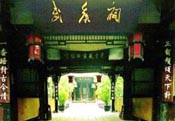 |
Wuhou Memorial Temple
Situated in the southern suburb of Chengdu, Wuhou Memorial Temple covers an area of 3.7 hectares. It was built in memory of ZhugeLiang, prime minister of the Shuhan State during the Three states Period in the third century (220-280). In the temple are forty-seven statues of Shuhan civil and military officials as well as steles, stone tablets, tripods, stoves and other relics.
|
|
Thatched Cottage of Du Fu
The Thatched Cottage of Du Fu is located at the side of the Flower Washing Brook in the western suburbs of Chengdu. The cottage is the former residence of the famous Tang Dynasty poet, Du Fu. In the year 759 A.D., at the age of 47, compelled by poverty and social upheaval, he moved from Gansu to the outskirts of Chengdu and built a thatched hut. During his stay of nearly four years, he composed more than 240 poems reflecting upon the misery of the people. The original residence disappeared long ago. It was renovated in the Ming and Qing dynasties and enlarged to its present scale in an expansive park, including a bamboo garden, several pavilions, and a number of bridges.
|
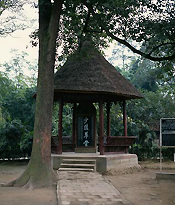 |
|
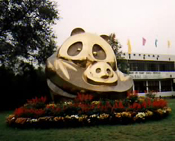 |
Giant Panda Breeding and Research Center
The giant pandas are not only a Chinese national treasure but are also beloved by people the world over. They are found only in Sichuan, Shaanxi and Gansu provinces. In total there are fewer than 1000, of which 80% are distributed within the territory of Sichuan province. Therefore, when visitors from home and abroad come to Chengdu, Sichuan Province one of their main objectives will be to see the giant pandas for themselves.
The Giant Panda Breeding Research Base is located on the mountain of Futoushan in the northern suburbs of the city, 10km away from the town center. The Giant Panda Museum is a unique museum set up for Giant Panda's in the world, it has been created and imitates the pandas' natural habitat in order that they might have a the best possible environment for rearing and breeding. The Center cares also for other rare and endangered wild animals. The Research Center covers an area of 560 mus (92 acres), 96% of which is verdure. Giant pandas, lesser pandas, black-necked cranes, white storks as well as over 20 species of rare animals are fed and bred there throughout the year. Verdant bamboo, bright flowers, fresh air, a natural hill scene and a beautiful artificial view are merged ingeniously at the base. |
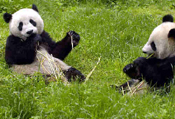 |
|
Sanxingdui (Three-Star Piles) Museum
Guanghan, called Luoxian and Hanzhou in ancient times, is situated in the north part of the Chengdu plain, 22km from Chengdu, capital of Sichuan Province. Being an important and famous city of Sichuan, it enjoys a long history, fertile soil and abundant produce, and has given birth to many well-known persons. The world-known Sanxingdui ruins are located by the Yazihe River 6km west of the Guanghan city. Sanxingdui is a cultural relic of the ancient Shu (Sichuan). It is an important archeological discovery which changed the people's understanding of ancient history and culture.
Sanxingdui Museum is located in Northeast of Sanxingdu archeological site. Covering an exhibition area of 4,000 square meters (about 1544.4 square miles), and opened in October 1997 this is an archeological museum with excellent modern facilities. The cultural relics in the museum were mostly unearthed from the Sanxingdui site.
If you want to visit a place to know more about Chinese Shu (Sichuan) culture, make it this one, for the civilization shown by the cultural relics can be called a true wonder.
|
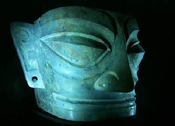 |
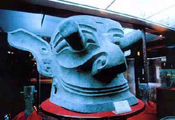 |
|
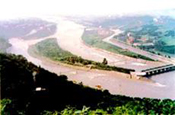 |
Dujiangyan Irrigation Project
The Dujiangyan Irrigation System represents ancient China's superb science and technology and is a milestone in the world history of water harnessing and irrigation technology advancement.
Built around 256 BC, Dujiangyan is the world's only and oldest diversion project without a dam. Still in use, it feeds a grid of irrigation canals watering 670,000 hectares of farmland in Sichuan, turning the province into the country's famous "land of rice and fish" since ancient times.
On November 29th, 2000, Dujiangyan was listed on world cultural heritages by UNESCO. |
|
Jinli Street:
It is said that Jinli Street is one of the oldest commercial street in West Shu history. The history can trace back to Qin and Han Dynasties. By combinign the culture of the Three Kingdoms Period with the folk customs of Sichuan, the buidlings are modeled on the architectural style of a traditional old town in western Sichuan Province from the Qing Dynasty. While several large restaurants can be found here, the real charm lies in the snack alley between Wuhou Temple and Jinli. It cannot be said that one does not experience Sichuan food ever reaches China. To catch a slice of real Chengdu life, Jinli Street is surely a great starting point. |
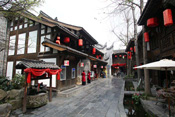 |
|
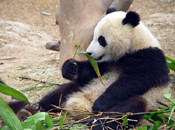
|
Chengdu Zoo
The Chengdu Zoo is one of the biggest zoos in China. It has over 30 halls of various designs reflected in green trees and bamboo and flowers and feeds over 300 animals. There are 3000 animals and 250 species, but the most popular beasts are undoubtedly the giant pandas. Ten pandas live at the zoo and laze away their days in the Panda Hall-the zoo's largest building which covers 5600 square meters. The zoo won a gold medal of the "Global 500 Best" of the UN Environmental Program in June 1989. |
|
Jiuzhaigou & Huanglong Scenic Area
Recognised by UNESCO in 1992 as a World Heritage Site. It is one of the star attractions in Sichuan as well as China. Jiuzhaigou is a place of idyllic beauty, often called a “fairyland on earth” for its amazing assortment of crystal clear lakes, turquoise streams and many spectacular waterfalls. Water is the king in this fairy world. Streams, lakes, waterfalls and shoals mix together to entitle Jiuzhaigou the name “King of the Waterscape”.
Huanglong Scenic Area is stuning gorgeous with its terraced, coloured limestone ponds of blues, turquoises, yellows and greens. The remote distance keeps the quietness and beauty of this National Park. Various sceneries gather here, such as snow moutains, valleies, virgin forests and calcified beaches. |
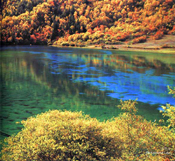 |
Recommended China Tours Including Chengdu:


|
|
| Other City |
|
 |
| Private China Tours |
|
 |
|

